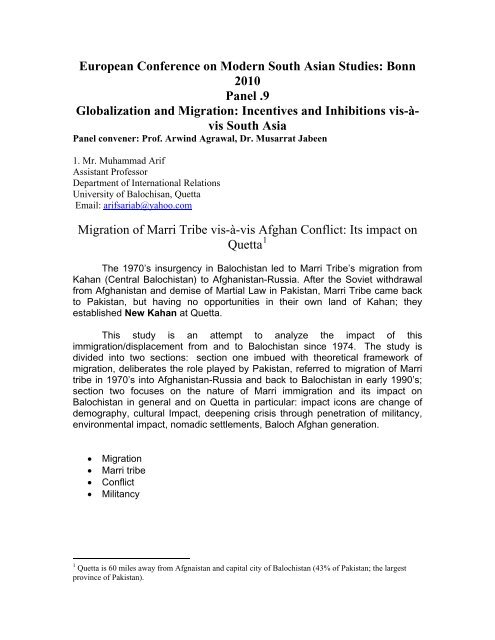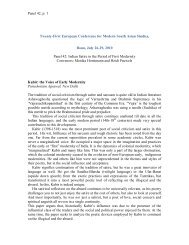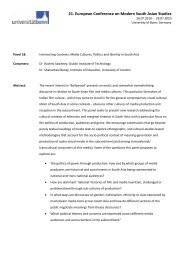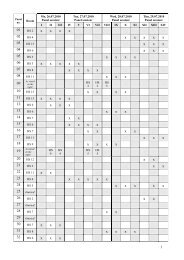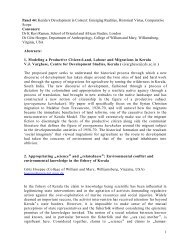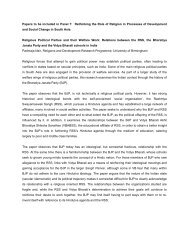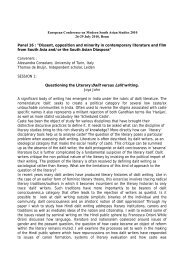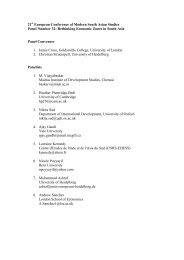European Conference on Modern South Asian Studies: Bonn 2010
European Conference on Modern South Asian Studies: Bonn 2010
European Conference on Modern South Asian Studies: Bonn 2010
Create successful ePaper yourself
Turn your PDF publications into a flip-book with our unique Google optimized e-Paper software.
<str<strong>on</strong>g>European</str<strong>on</strong>g> <str<strong>on</strong>g>C<strong>on</strong>ference</str<strong>on</strong>g> <strong>on</strong> <strong>Modern</strong> <strong>South</strong> <strong>Asian</strong> <strong>Studies</strong>: B<strong>on</strong>n<br />
<strong>2010</strong><br />
Panel .9<br />
Globalizati<strong>on</strong> and Migrati<strong>on</strong>: Incentives and Inhibiti<strong>on</strong>s vis-àvis<br />
<strong>South</strong> Asia<br />
Panel c<strong>on</strong>vener: Prof. Arwind Agrawal, Dr. Musarrat Jabeen<br />
1. Mr. Muhammad Arif<br />
Assistant Professor<br />
Department of Internati<strong>on</strong>al Relati<strong>on</strong>s<br />
University of Balochisan, Quetta<br />
Email: arifsariab@yahoo.com<br />
Migrati<strong>on</strong> of Marri Tribe vis-à-vis Afghan C<strong>on</strong>flict: Its impact <strong>on</strong><br />
Quetta 1<br />
The 1970’s insurgency in Balochistan led to Marri Tribe’s migrati<strong>on</strong> from<br />
Kahan (Central Balochistan) to Afghanistan-Russia. After the Soviet withdrawal<br />
from Afghanistan and demise of Martial Law in Pakistan, Marri Tribe came back<br />
to Pakistan, but having no opportunities in their own land of Kahan; they<br />
established New Kahan at Quetta.<br />
This study is an attempt to analyze the impact of this<br />
immigrati<strong>on</strong>/displacement from and to Balochistan since 1974. The study is<br />
divided into two secti<strong>on</strong>s: secti<strong>on</strong> <strong>on</strong>e imbued with theoretical framework of<br />
migrati<strong>on</strong>, deliberates the role played by Pakistan, referred to migrati<strong>on</strong> of Marri<br />
tribe in 1970’s into Afghanistan-Russia and back to Balochistan in early 1990’s;<br />
secti<strong>on</strong> two focuses <strong>on</strong> the nature of Marri immigrati<strong>on</strong> and its impact <strong>on</strong><br />
Balochistan in general and <strong>on</strong> Quetta in particular: impact ic<strong>on</strong>s are change of<br />
demography, cultural Impact, deepening crisis through penetrati<strong>on</strong> of militancy,<br />
envir<strong>on</strong>mental impact, nomadic settlements, Baloch Afghan generati<strong>on</strong>.<br />
• Migrati<strong>on</strong><br />
• Marri tribe<br />
• C<strong>on</strong>flict<br />
• Militancy<br />
1 Quetta is 60 miles away from Afgnaistan and capital city of Balochistan (43% of Pakistan; the largest<br />
province of Pakistan).
2. Miss Hussan Ara Magsi<br />
Lecturer<br />
Political science Department,<br />
University of Balochistan, Pakistan<br />
Cell no-92-0321-8025141<br />
e-mail-calopaetra@hotmail.com<br />
Migrati<strong>on</strong> a force to reduce poverty and unemployment in <strong>South</strong> Asia:<br />
Focus <strong>on</strong> IT industry<br />
Migrati<strong>on</strong> is universal phenomen<strong>on</strong>. Migrati<strong>on</strong> from <strong>South</strong> Asia is pushed by:<br />
poverty, unemployment and search for better life standard. Migrati<strong>on</strong> from <strong>South</strong> Asia<br />
is <strong>on</strong>e of the most important livelihood management instruments. Poor ec<strong>on</strong>omic<br />
c<strong>on</strong>diti<strong>on</strong>s and inequalities prevalent in <strong>South</strong> <strong>Asian</strong> societies are causing increase in<br />
migrati<strong>on</strong> from <strong>South</strong> Asia.<br />
The importance of Informati<strong>on</strong> Technology cannot be underestimated as it<br />
dominates all fields of business e-g service sector. Foreign exchange earned in IT from<br />
the overseas citizens is major source of financial strength of <strong>South</strong> Asia. The IT industry<br />
emanates enormous job opportunities and <strong>South</strong> Asia is no excepti<strong>on</strong> to get attracted to<br />
this very fact. This study is significant to high light IT industry as causative factor of<br />
migrati<strong>on</strong> from <strong>South</strong> Asia, determines the Impact of migrati<strong>on</strong> of IT workers from <strong>South</strong><br />
Asia and presents the strategy to network with ex-<strong>South</strong> <strong>Asian</strong>s IT workers to reduce<br />
poverty and unemployment in <strong>South</strong> Asia.<br />
Key words:<br />
1. Migrati<strong>on</strong><br />
2. IT industry<br />
3. Poverty alleviati<strong>on</strong><br />
4. Unemployment
3. Mrs. Rubeena Batool,<br />
Lecturer,<br />
Gender Development <strong>Studies</strong>,<br />
University of Balocchistan,<br />
Quetta.<br />
Post 9/11 Feminizati<strong>on</strong> of Migrati<strong>on</strong> and Pakistan<br />
Post 9/11 internati<strong>on</strong>al migrati<strong>on</strong> trends have at least three outcomes: deportati<strong>on</strong><br />
of immigrants from Pakistan settled in Europe and USA, discouraging immigrati<strong>on</strong><br />
policies for Pakistani workers in internati<strong>on</strong>al market have increased unemployment in<br />
Pakistan, war <strong>on</strong> terrorism have increased number of IDPs in Pakistan reflecting<br />
migrati<strong>on</strong> from Pakistan.<br />
It is found that the above menti<strong>on</strong>ed outcomes trickle to women populati<strong>on</strong>. The<br />
study signifies to evaluate migrati<strong>on</strong> trends to gauge feminizati<strong>on</strong> of migrati<strong>on</strong>. Part <strong>on</strong>e<br />
of the study notices the feminizati<strong>on</strong> of migrati<strong>on</strong> trends vis-à-vis Pakistan and part two<br />
proposes to manage post 9/11 feminizati<strong>on</strong> of migrati<strong>on</strong>.<br />
Key word:<br />
1. Feminizati<strong>on</strong><br />
2. Migrati<strong>on</strong><br />
3. War <strong>on</strong> terror
Migrati<strong>on</strong> Remittances and Development in Pakistan in 21 st Century<br />
4. Qazi Muhammad Tousif Akhtar<br />
Chairman Department of Ec<strong>on</strong>omics<br />
University of Baluchistan, Quetta<br />
Email: qmtousif@gmail.com<br />
Email:qmtousif@yahoo.com<br />
Abstract: World Bank simulati<strong>on</strong> indicates that an increase in the share of<br />
remittances in a country’s GDP by <strong>on</strong>e tenth would result in a 1.6% reducti<strong>on</strong> in<br />
poverty. Todaro 2 interprets relati<strong>on</strong>ship between migrati<strong>on</strong>, remittances and<br />
development: through migrati<strong>on</strong>, additi<strong>on</strong>al funds can be secured for the individual<br />
household. Evidence from Pakistan supports this relati<strong>on</strong>ship; that remittances are critical<br />
for meeting the basic needs of household e-g food, housing, health and<br />
educati<strong>on</strong>. Remittances define financing in private c<strong>on</strong>sumpti<strong>on</strong> and shape the labour<br />
supply and educati<strong>on</strong> decisi<strong>on</strong>s of household.<br />
Remittance flows are not <strong>on</strong>ly the sec<strong>on</strong>d-largest source of external funding for<br />
Pakistan behind foreign direct investment (FDI) they are also more stable than private<br />
capital flows. Transnati<strong>on</strong>al migrati<strong>on</strong> from Pakistan fetches huge foreign exchange as<br />
remittances; e-g remittances to Pakistan c<strong>on</strong>tinued to grow steadily (from $1.075 to<br />
$6.100 billi<strong>on</strong>) in 2000 to 2007. The study addresses the following questi<strong>on</strong>s:<br />
1. How remittance channels can be made more accessible<br />
2. How remittances can be made more "development friendly"<br />
Key words: Migrati<strong>on</strong> - Remittances - Development - poverty<br />
2 Todaro and Smith, (1995), “Ec<strong>on</strong>omic Development”, tenth editi<strong>on</strong>, Florida, Pears<strong>on</strong>
5. Dr. Rita Afsar<br />
Senior Research Fellow (<strong>on</strong> leave)<br />
Bangladesh Institute of Development <strong>Studies</strong><br />
Dhaka<br />
Labour Recruitment Pitfalls and Migrati<strong>on</strong> Outcome: Migrati<strong>on</strong> from<br />
Bangladesh to the Gulf Countries<br />
In c<strong>on</strong>temporary development discourse protecti<strong>on</strong> of worker’s rights and<br />
migrati<strong>on</strong> management have emerged as the major challenges for both sending and<br />
receiving countries. The major focus of the paper is to examine the various recruitment<br />
mechanisms, processes and labour c<strong>on</strong>tractual arrangements experienced by migrant<br />
workers employed in the Gulf States, and their different outcomes based largely <strong>on</strong><br />
recounting pers<strong>on</strong>al experiences of return migrants comprising both men and women as<br />
well as legal and irregular migrants. The findings from interviews with returned migrants<br />
are supplemented by interviews with private recruiting agencies including sub-agents,<br />
and other stakeholders.<br />
The paper highlights how the search for a ‘Bhalo’ visa or the <strong>on</strong>e that would yield<br />
better work opportunities and higher incomes can trigger migrati<strong>on</strong>. The paper identifies<br />
at least three types of outcomes – positive; mixed with both positive and negative and<br />
negative.<br />
Burden of repayment of loans has emerged as an important factor affecting<br />
migrati<strong>on</strong> decisi<strong>on</strong>. The paper emphasises that the government must ensure regulatory<br />
compliance of the recruiting agencies and other service providers involved in channelling<br />
overseas migrati<strong>on</strong>. Good governance is crucial to maximise the benefits of migrati<strong>on</strong>.<br />
Key Words:<br />
‘Bhalo’ Visa; Repayment of Loan; Regulatory Compliance
6. Dr. Musarrat Jabeen (LEAD FELLOW),<br />
Chairpers<strong>on</strong>,<br />
Associate Professor, Internati<strong>on</strong>al Relati<strong>on</strong>s,<br />
University of Balocchistan,<br />
Quetta.<br />
Musarratjabeen7@gmail.com, musarratjabeen7@yahoo.com<br />
Managing Migrati<strong>on</strong> Trends in Balochistan 3<br />
In current internati<strong>on</strong>al relati<strong>on</strong>s; the migrati<strong>on</strong> realism has become focused<br />
avenue of research. Migrati<strong>on</strong> trends decompose the development potential of regi<strong>on</strong>s<br />
like Balochistan. Migrati<strong>on</strong> in Balochistan is not well managed as Balocistan is passively<br />
globalized; pr<strong>on</strong>e to wartime migrati<strong>on</strong>, and brain drain trends. This study is carried <strong>on</strong> in<br />
assumpti<strong>on</strong>: that if migrati<strong>on</strong> is properly managed it can c<strong>on</strong>tribute to the growth and<br />
prosperity of natives-migrants and Balochistan-Pakistan. This paper is significant to flash<br />
Balochistan in nati<strong>on</strong>al and regi<strong>on</strong>al migrati<strong>on</strong> trends as the province is growing geoec<strong>on</strong>omically,<br />
and shaping the future regi<strong>on</strong>al-nati<strong>on</strong>al development. The study aims to<br />
provide policy opti<strong>on</strong>s to harness the migrati<strong>on</strong> resources for the benefit of individual<br />
migrants and society.<br />
Key words:<br />
• Migrati<strong>on</strong><br />
• Globalizati<strong>on</strong><br />
• C<strong>on</strong>flict<br />
3 Balochistan is 43% of Pakistan: the largest province the country, c<strong>on</strong>fluences <strong>South</strong> Asia-Middle East-<br />
Central Asia
7. Dr. Rashmi Jain, University of Rajasthan<br />
Assistant Professor<br />
Department of Sociology<br />
University of Rajasthan<br />
Jaipur – 302055, India<br />
Globalizati<strong>on</strong> and Migrati<strong>on</strong> of Indigenous People<br />
The process of development involves change in the desired directi<strong>on</strong><br />
motivated by the interests of public welfare. Often such change brings<br />
in c<strong>on</strong>flict of mutually opposite interests. In terms of theory of social<br />
engineering as propounded by Dean Roscoe Pound, the individual,<br />
social and public interests come into c<strong>on</strong>flict with each other. These<br />
c<strong>on</strong>flicts are to be taken care of by the legislators, law makers and<br />
policy makers.<br />
The proposed paper deals with the how mega development projects<br />
(e.g., major irrigati<strong>on</strong> dam projects, Special Ec<strong>on</strong>omic Z<strong>on</strong>es, real<br />
estate projects etc.) are promoted in the interests of corporate world<br />
or to serve larger public interests at the cost of individual interests of<br />
those who are settled <strong>on</strong> the land for past many generati<strong>on</strong>s. This<br />
development leads to displacement and migrati<strong>on</strong> of multitude of<br />
people losing their livelihood, hereditary habitat, culture and<br />
community life.<br />
Rajasthan has been home to many tribal and indigenous communities.<br />
These communities have been characterized by subsistence ec<strong>on</strong>omy<br />
and sustaining <strong>on</strong> their natural envir<strong>on</strong>ment. Most of these people<br />
have remained isolated from the rural and urban communities. They<br />
have been c<strong>on</strong>fining themselves to forests and remote areas bey<strong>on</strong>d<br />
mainstream society.<br />
This article is about the rights of these migratory people in the wider<br />
c<strong>on</strong>text of post-independent C<strong>on</strong>stituti<strong>on</strong> and Law in a socio-legal<br />
perspective. The C<strong>on</strong>stituti<strong>on</strong> of India guarantees certain rights to<br />
individuals accorded as Fundamental Rights but also takes care of<br />
public interests under Directive Principles of State Policy. This paper<br />
raises various legal issues pertaining to various c<strong>on</strong>stituti<strong>on</strong>al<br />
provisi<strong>on</strong>s and human rights in this regard so as to analyze it in a<br />
holistic socio-legal perspective of the phenomen<strong>on</strong>.
8. Po<strong>on</strong>am Sharma<br />
Migrant Women and their Rights<br />
Migrant women in all regi<strong>on</strong>s at nati<strong>on</strong>al level face particular barriers<br />
and challenges to the fulfillment of their human rights and gender<br />
inequality. In most cases, such women are not welcomed and basic<br />
rights and facilities are not extended to them by the native<br />
envir<strong>on</strong>ment. Migrant women are treated with half and irregular<br />
status. It is a paradox that women’s effort to strengthen their situati<strong>on</strong><br />
in their own place and their endeavor for social protecti<strong>on</strong> does not<br />
improve their positi<strong>on</strong> in the migrated regi<strong>on</strong>. For these, specific<br />
efforts need to be made to recognize their presence. Some very vital<br />
rights such as political rights, labor rights, ec<strong>on</strong>omic and social rights<br />
al<strong>on</strong>g with the legal protecti<strong>on</strong> need to be procured.<br />
Migrati<strong>on</strong> is occurring within states towards all directi<strong>on</strong>. Large<br />
number of women migrate, no doubt, out of necessity, due to<br />
ec<strong>on</strong>omic need and in case of change of employment of their<br />
husbands. Today’s alarming situati<strong>on</strong> of populati<strong>on</strong> and neo-liberal<br />
ec<strong>on</strong>omic atmosphere is causing enhancement in the event of<br />
migrati<strong>on</strong> in search of livelihood.<br />
It is acceptable in such a circumstance that such women are in high<br />
probability of meeting with hostility and criminalizati<strong>on</strong>.<br />
There is a profound hypocrisy in the behavior of local elements who<br />
want to take advantage of migrant’s labor and <strong>on</strong> the other hand they<br />
exploit migrants emoti<strong>on</strong>ally keeping them under social servitude.<br />
The present abstract highlights the research <strong>on</strong> the plight of migrant<br />
women labourers in Rajasthan (India).<br />
Migrant women are taken as commodity to fulfill the local needs. In<br />
such circumstances migrati<strong>on</strong> issue must be dealt with the liberal<br />
c<strong>on</strong>siderati<strong>on</strong> so that migrant women may acquire sustainable<br />
development through proper sympathetic envir<strong>on</strong>ment. For this,<br />
authority must procure to them basic human rights relating to<br />
livelihood, shelter, health, envir<strong>on</strong>ment, educati<strong>on</strong> and human dignity.
9. Dr. Anuradha Parasar<br />
Associate Professor, IILM, Gurga<strong>on</strong>, India<br />
Internal Migrati<strong>on</strong> In India and Inter-State Migrant<br />
Workmen Act, 1976 – An Analysis<br />
Internal migrati<strong>on</strong> has been a necessity in India since time immemorial. In<br />
present c<strong>on</strong>text internal migrati<strong>on</strong> is increasing at an exp<strong>on</strong>ential rate due to<br />
different drivers and accelerators of migrati<strong>on</strong>s there by leading in prouncing<br />
various migrant workers issues to be given priority am<strong>on</strong>gst social problems.<br />
However Inter-state Migrant Workmen Act has been in force in India since<br />
1976 to redress Migrant workers problem.<br />
The present paper aims at holistically analysing the Internal Migrati<strong>on</strong><br />
Scenario in India with reference to migrati<strong>on</strong> - nature, types, pattern,<br />
magnitude and c<strong>on</strong>diti<strong>on</strong> of migrant workers. The paper also examines the<br />
effectiveness and efficacy of Inter – State Migrant Workmen Act.<br />
The paper suggest ways and means to address migrant worker problems.<br />
The paper suggest and recommends further how to make Inter- State<br />
Migrant Workmen Act to achieve its objective in true nature and spirit to<br />
resolve migrant worker's issues.
10. Prof. Dr. Arwind Kumar Agrawal<br />
Professor & Head, Department of Sociology<br />
& Director, Centre for the Study of Social Exclusi<strong>on</strong> & Inclusive Policy<br />
University of Rajasthan<br />
Jaipur - 302 055, India<br />
Inequal Development, Migrati<strong>on</strong> and Regi<strong>on</strong>al Politics:<br />
A Socio-Legal Perspective<br />
Indian c<strong>on</strong>stituti<strong>on</strong> enshrines the nati<strong>on</strong>al aspirati<strong>on</strong>s and guidelines<br />
for development of the nati<strong>on</strong>. The Indian citizen is encouraged to<br />
pursue socio-ec<strong>on</strong>omic mobility with freedom to pursue any occupati<strong>on</strong><br />
and to settle anywhere in the country. Spread of educati<strong>on</strong>, opening<br />
up of new avenues of employment in the public and private sector led<br />
to internal migrati<strong>on</strong> in last sixty years after independence causing<br />
tremendous urbanizati<strong>on</strong> and cross-cultural exchanges within the<br />
country. However, the Indian laws have yet to fully address<br />
themselves to the problem of the internal migrants. Since the majority<br />
of migrants tend to work in the unorganized sector of agriculture and<br />
mining, this paper focuses <strong>on</strong> the labour laws in India dealing with the<br />
internal migrati<strong>on</strong> in these two sectors. Beginning with the<br />
C<strong>on</strong>stituti<strong>on</strong>al provisi<strong>on</strong>s, covering the statutory laws, the paper tries<br />
to dem<strong>on</strong>strate the inadequacy of the laws in a socio-legal perspective.<br />
It c<strong>on</strong>cludes that the problem of internal migrati<strong>on</strong> is a nati<strong>on</strong>al<br />
problem, which not <strong>on</strong>ly requires enacting laws and creating legal<br />
enforcement agencies, but also entails a multi-pr<strong>on</strong>ged strategy<br />
involving socio-political and ec<strong>on</strong>omic inputs.<br />
With the weakening of nati<strong>on</strong>al parties in the regi<strong>on</strong>al political arena<br />
has led to emergence of regi<strong>on</strong>al parties. Often these regi<strong>on</strong>al parties<br />
try to c<strong>on</strong>solidate their vote banks by promoting narrow parochial<br />
regi<strong>on</strong>al aspirati<strong>on</strong>s. One of these parochial demands by these regi<strong>on</strong>al<br />
parties is priority treatment to s<strong>on</strong>s of soil over locally settled internal<br />
migrants. This politics of regi<strong>on</strong>alism has been witnessed in many<br />
states leading to violence, harrassment and victimisati<strong>on</strong> against the<br />
migrant groups from within the country. This paper would discuss<br />
various issues related to internal migrati<strong>on</strong> and politics of regi<strong>on</strong>alism<br />
in the light of various laws, c<strong>on</strong>stituti<strong>on</strong>al provisi<strong>on</strong>s and guarantees<br />
given to an Indian citizen in a socio-legal framework.


